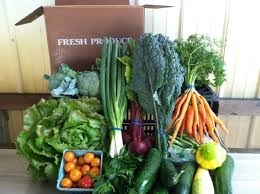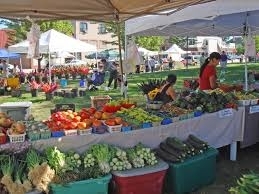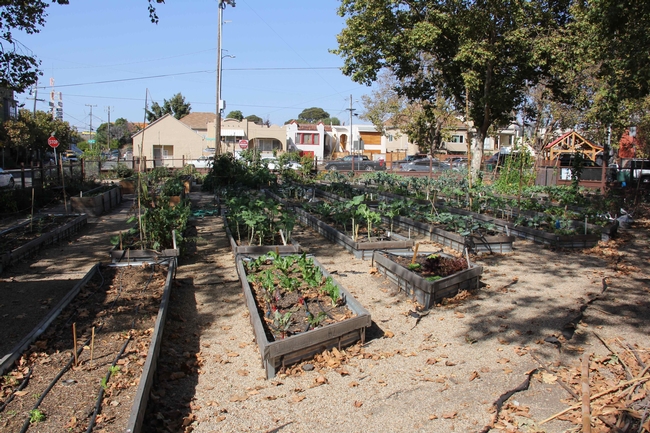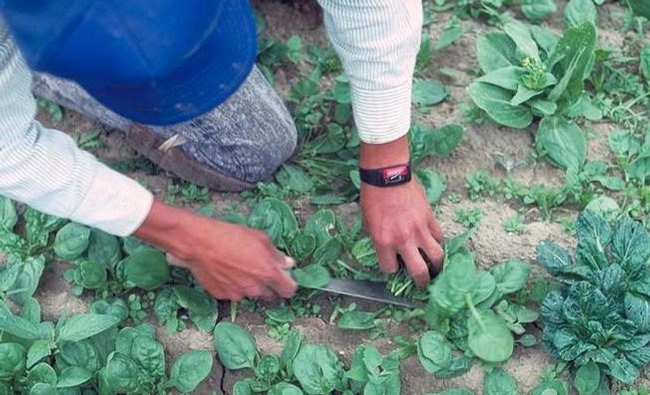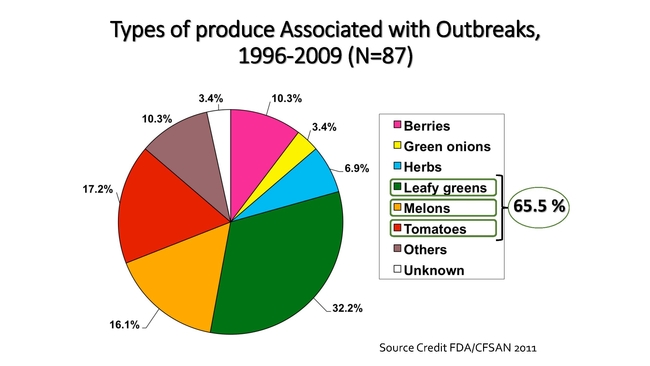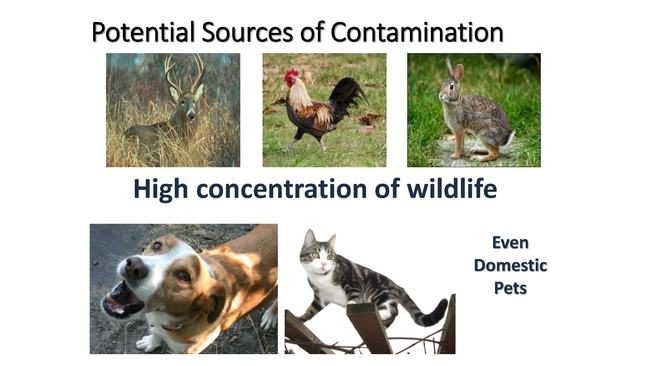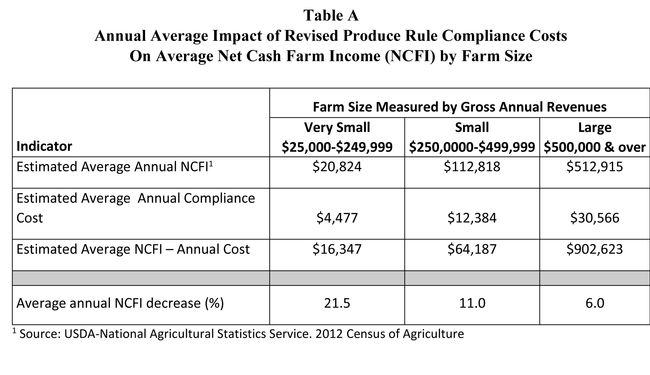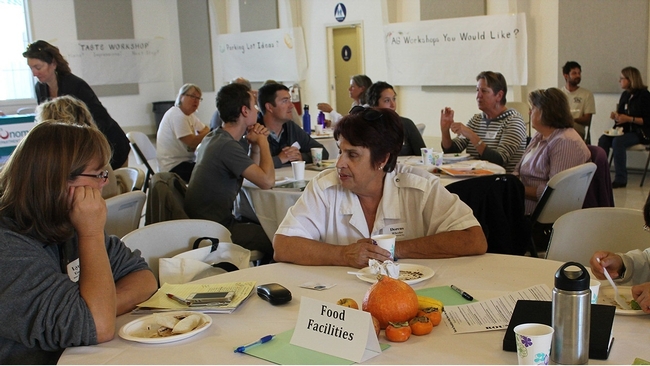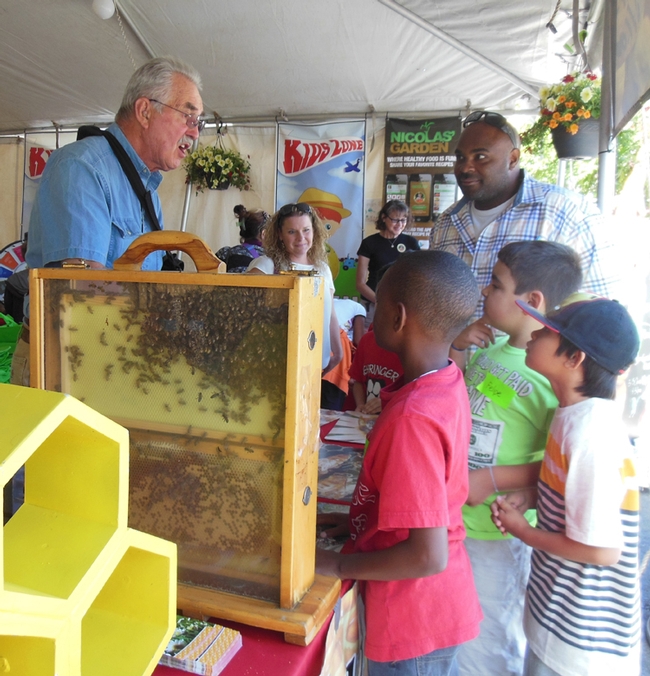Small Farm News
Recently Passed Legislation Related to Direct Marketing and Food Safety
I erroneously referred to requirements in some recently passed legislation related to direct marketing as "regulations". So I am posting an edited version of the blog. It also includes some additional information.
Recently Passed Legislation Related to Direct Marketing and Food Safety
California's Legislature recently passed several bills related to direct marketing and food safety. The California Department of Food and Agriculture (CDFA) has recently implemented some new requirements related to these bills. While these requirements could increase growers' costs, they also have the potential to foster more favorable market conditions for smaller farms engaged in direct marketing.
Some of the major provisions in these bills and their requirements are summarized below. It would be helpful for producers who direct market to review CDFA's Small Farm Food Safety Guidelines, http://www.cdfa.ca.gov/is/i_&_c/sffsg.html since they are referenced in all three pieces of legislation. Note that they are guidelines, rather than requirements. CDFA intends to revise them to be consistent with the federal Food Safety Modernization Act (FSMA) requirements, after the FDA has finalized the FSMA regulations (which I have heard could occur around October, 2015.)
Please note that this is NOT a complete listing of the requirements associated with AB 224, AB 1871 and AB 1990. I have added bold and italicized fonts to emphasize specific phrases. If you have any questions or concerns about these new regulations, please email me, Shermain Hardesty, Leader of the UC Small Farm Program, shermain@primal.ucdavis.edu.
AB 224 CSA Programs (Gordon—signed September 28, 2013)
-
Authorized CDFA to adopt regulations establishing a registration program for CSA producers, including those supplying multi-farm CSAs
- $75 annual fee, $25 for each amendment
- Registration form is in the CSA section of: http://www.cdfa.ca.gov/is/i_&_c/cfm.html
- The form requires producers to certify the following: “…to the best of my knowledge and belief, this report is true and complete. I further certify that I am knowledgeable and intend to produce in accordance with good agricultural practices as published by the department. See
http://www.cdfa.ca.gov/is/i_&_c/cfm.html for a copy of guidelines. I am aware I must also comply with any other local, state or federal laws.”
- Required CDFA to post Small Farm Food Safety Guidelines for crops on its website as mentioned above
- Required CDFA to post Food Safety Guidelines for processed potentially hazardous foods. Such foods fall under the jurisdiction of the California Department of Public Health and local health agencies, rather than CDFA. Thus, this will require inter-departmental coordination and could require significant time because the food safety requirements for such foods vary considerably
- Imposed specific requirements related to the labeling and maintenance of consumer boxes and containers that are used in CSA programs to deliver farm products in order to facilitate traceback
- Label the consumer box or container used to deliver farm products to the consumer with the name and address of the farm delivering the box or container
- Maintain the consumer boxes or containers in a condition that prevents contamination
- Inform consumers, either by including a printed list in the consumer box or container or by delivering a list electronically to the consumer, of the farm of origin of each item in the consumer box or container
- Maintain records that document the contents and origin of all of the items included in each consumer box or container, in accordance with department regulations
- Comply with all labeling and identification requirements for shell eggs and processed foods imposed pursuant to the provisions of the Health and Safety Code, including, but not limited to, the farm's name, physical address, and telephone number
- Specified that a registered California direct marketing producer is an approved source, subject to compliance with specified provisions of the law, and that any whole uncut fruit or vegetable or unrefrigerated shell egg grown or produced in compliance with all applicable federal, state, and local laws, regulations, and food safety guidelines shall be deemed to be from an approved source
AB 1871 Certified Farmers Markets (Dickinson—signed September 26, 2014)
- Raised fee paid by Certified Farmers Markets for their vendors from 60 cents to $2 daily. Only farmers used to pay the fee, but now extended to all vendors, including food and crafts sellers in non-agricultural sections
- Required farmers to register with County Ag Dept. and pay a fee annually
- When farmers get their Certified Producers Certification for selling at Certified Farmers Markets, required them to attest that they are “knowledgeable of and intend to produce in accordance with 'good agricultural practices' (GAPs)--as outlined in CDFA's Small Farm Food Safety Guidelines mentioned above. CDFA will soon be adding a supplemental page to meet this requirement to either its online fill-in form or at the Ag Commissioner's office when producers pick up their certificates
- Required farmers selling at certified farmers markets to post a conspicuous sign or banner at their stand that identifies the farm/ranch by name, the county where the farm/ranch produces the products being offered for sale is located, and a statement that “We Grow What We Sell” or “We Raised What We Are Selling” or similar phrases that clearly represent that the farm or ranch is only selling agricultural products that they themselves have grown or raised on California land that they possess or control. Product sales by different farms at the same vendor stand shall separate the products from each farm or ranch and correspondingly post the required sign or banner in direct relationship with the sales display of the products produced by each farm.
- Authorized use of the term “California grown” and similar terms for marketing, advertising, or promotional purposes only to identify food or agricultural products that have been produced in the state or harvested in its surface or coastal waters, and made the fraudulent use of the term or a deliberately misleading or unwarranted use of the term a misdemeanor
AB 1990 Community Food Producers (Gordon—signed September 26, 2014)
- Defined “community food producers” as an approved source that includes, but is not limited to, community gardens, personal gardens, school gardens, and culinary gardens
- Unless a local jurisdiction adopts an ordinance regulating community food production or agricultural production that prohibits the activity, AB 1990 permits a community food producer or gleaner to sell or provide whole uncut fruits or vegetables, or unrefrigerated shell eggs, directly to the public, to a permitted restaurant, or a cottage food operation if the community food producer meets all of the following requirements in addition to any requirements imposed by an ordinance adopted by a local jurisdiction:
(1) Agricultural products shall be grown or produced in compliance with subdivision (b) of Section 113735 (section of the California Retail Food Code defining 'approved source')
(2) Agricultural products shall be labeled with the name and address of the community food producer.
(3) Conspicuous signage shall be provided in lieu of a product label if the agricultural product is being sold by the community food producer on the site of production. The signage shall include, but not be limited to, the name and address of the community food producer.
(4) Best management practices as described in CDFA's Small Farm Food Safety Guidelines (as mentioned above), but not limited to, safe production, processing, and handling of both nonpotentially hazardous and potentially hazardous foods (see http://www.cdfa.ca.gov/is/i_&_c/sffsg.html)
(5) Egg production shall be limited to 15 dozen eggs per month.
- Permits a local city or county health enforcement office may require a community food producer or gleaner to register with the city or county and to provide specified information, including, but not limited to, their name, address, and telephone number
Please note that this is NOT a complete listing of the requirements associated with AB 224, AB 1871 or AB 1990.
Food Safety Modernization Act Comments Due December 15, 2014
The Food Safety Modernization Act
In late September, 2014, the FDA released a modified set of draft regulations for the Food Safety Modernization Act's (FSMA) Produce Rule and the Preventive Controls for Human Food Rule; they had been revised considerably in response to extensive comments submitted by farmers and organizations during 2013.
Comments about these revised rules are due to the FDA by December 15, 2014. If you haven't already done so, I encourage you to review the key revisions summarized on the FDA FSMA website (http://www.fda.gov/food/guidanceregulation/fsma/default.htm), as well as my comments below regarding some of the key revisions. You might also want to look at the National Sustainable Agriculture Coalition's excellent review of the FSMA: http://sustainableagriculture.net/fsma/; I reviewed their materials and borrowed some their language for this article.
You can submit your comments to the FDA at: http://www.regulations.gov/#!submitComment;D=FDA-2011-N-0921-0973 (for the Produce Rule) and http://www.regulations.gov/#!submitComment;D=FDA-2011-N-0920-1553 (for the Preventive Controls Rule).
Revised Definition of Covered Farms
The FDA has revised its definition of covered farms. It is now proposing that farms or farm mixed-type facilities with average annual gross revenues of $25,000 or less from produce sales will not be covered by the Produce Rule. Originally, the proposed rule related to all farm sales; thus, a small-scale wheat farmer seeking to diversify by growing a few rows of tomatoes would have been covered by the rule.
However, the FSMA's $500,000 sales threshold (adjusted for inflation) for a farm to be eligible for modified requirements through a qualified exemption still relates to total farm revenues, rather than just produce sales. This cannot be changed because the text of the FSMA legislation specifically refers to “all food sales” A farm is eligible for modified requirements if it:
- has less than $500,000 in annual gross sales (adjusted for inflation) of all food products (includes commodities, hay, dairy, livestock as well as produce) over a previous three-year period AND
- sells the majority of the food directly to “qualified end-users”--consumers, restaurant and retail food establishment (e.g., a grocery store) that is located in the same state as the farm or not more than 275 miles from the farm.
Complying with the modified requirements means that a farm only needs to:
- Provide the name and complete address of the farm where the produce was grown on either a food packaging label or on a sign at the point of purchase;
- Comply with the “compliance and enforcement requirements” of the Produce Rule; and
- Be subject to the provisions regarding the withdrawal of your status as a partially covered (“qualified exempt”) operation; FDA can revoke your “qualified exempt” status in certain circumstances.
Broadened Definition of a “Farm”
Under the revised FSMA provisions, a farm that packs or holds raw agricultural products grown on another farm under a different ownership no longer has to register as a “food facility”. The original rule would have required a farm that aggregates produce from multiple farms for a CSA program to meet the Preventive Controls requirements. The revised rules will allow the farm to comply only with the Produce Rule. The “farm” may also:
- Pack or hold raw agricultural products;
- Manufacture or process food for on-farm consumption only;
- Dry/dehydrate raw agricultural products, as long as there is no additional processing; and/or label and package raw agricultural products as long as there is no additional processing.
Please be aware that the FSMA's terminology is very nuanced. Chopping or slicing fresh produce for sale – like carrots or apples – is considered to be processing, which means that you operate a “facility.” (Certain harvesting activities like trimming outer leaves of produce, or removing stems or husks, are not considered processing.). Washing is considered part of harvesting when done in the field. But, if it is done during the production of fresh-cut produce, for example, it is considered manufacturing or processing. Labeling and packaging are considered manufacturing activities unless you are labeling or packaging a raw agricultural product and are not doing any additional manufacturing or processing to the product. If there is no additional manufacturing or processing, labeling and packaging are considered farm activities and do not trigger the facility definition.
However, if these activities are done off of a farm, such as when farms collaborate to have a jointly controlled packing operation, these activities will trigger the manufacturing/processing definition above and would mean that you operate a “facility”. As a facility, the farm would be required to establish and implement hazard analysis and risk-based preventive controls for human food. FDA is currently seeking comment on whether the Preventive Rule should require a “facility” to: (a) conduct product testing to verify implementation and effectiveness of preventive controls; (b) conduct environmental monitoring to verify implementation and effectiveness of preventive controls if contamination of a ready-to-eat food with an environmental pathogen is a significant hazard; and (c) require supplier controls when the receiving facility's hazard analysis identifies a significant hazard for a raw material or ingredient, and that hazard is controlled before the facility receives the raw material or ingredient from a supplier. Clearly, these requirements would be considerably more complex and expensive to comply with than the requirements of the Produce Rule for farms.
Revised Water Quality Standard and Testing Are More Flexible
The FDA is proposing various revisions to the microbial standard for water that is directly applied during the growing of produce (other than sprouts). The agency is updating the microbial quality standard to reflect data that supports the EPA's 2012 recreational water quality criteria.
For farms that have to test their water, the FDA is proposing three numerical standards below for testing.
- No detectible E. coli present per 100 ml of water: This standard would apply to water used for an activity during and after harvest, water used to make agricultural teas, and water used in sprout irrigation. The quality of untreated surface water used for these purposes must be tested from each source of the water “with an adequate frequency to provide reasonable assurances that the water meets the required standard”. You must have adequate scientific data or information to support your testing frequency.
- Farms using untreated groundwater for purposes that trigger a testing requirement will now have to test their water supply a maximum of 5 times in the first year (4 per year/growing season plus one test per year) rather than testing on a quarterly basis as originally proposed. Their untreated groundwater used to irrigate in a manner that directly contacts the harvestable portion of the crop will have to meet the following standard: a geometric mean of no more than 126 colony forming units (CFUs) per 100 ml.
- Testing of untreated surface water used for growing produce other than sprouts involving direct contact with the harvestable portion will require the collection of 20 samples over the first 2 years, followed by an annual minimum sampling of 5 per year, rather than monthly or weekly as previously required. The water will have to meet the following standard: a statistical threshold value (STV) of 410 CFUs generic E. coli per 100 ml for a single water sample, and a geometric mean of no more than 126 CFU per 100 ml. If your water testing shows that you exceed these values, you can still use your water, as long as you apply an appropriate time interval between the end of irrigation and harvest as determined by calculating the “microbial die-off”.
Clarification of Provisions on Wild Animals
Manure Application Interval Will Be Studied Further
The FDA had previously proposed a nine-month minimum time interval between the application of untreated soil amendments of animal origin (including raw manure) and harvesting. This requirement conflicted directly with the USDA National Organic Program's standards, which require a 120-day interval between the application of raw manure for crops in contact with the soil and 90 days for crops not in contact with the soil. The FDA now proposed to conduct a risk assessment and extensive research to strengthen scientific support for any future proposal. Additionally, the FDA is proposing to eliminate its previously proposed 45-day minimum application interval for compost.
Significant Compliance Costs Remain for Small-scale farms
The provisions reviewed above all were improvements over the original FSMA Produce Rule. The revised rules reduced the estimated number of farms in the United States covered by the FSMA by 4,708, of which 2,885 are “very small”. However, some of the provisions still impose disproportionately high compliance costs on smaller-scale farms, as indicated below in Table A. Smaller-scale farms typically have very constrained cash flows. The added expenses to comply with the FSMA makes their cash flows even tighter and reduces their already low level of profitability. If a "very small" farm loses over a fifth of its net cash farm income, this could have significant impacts on its sustainability. And these decreases do not include the one-time capital expenses that a farm may have to incur, such as to modify restrooms or handwashing facilities and to build fences!
The percentage decrease in net cash farm income attributable to the costs of complying with the FSMA declines as farm size increases. Clearly, there are economies of scale in complying with the FSMA. The FSMA includes delayed implementation of FSMA compliance for smaller-scale farms. Policymakers should also consider providing subsidies and/or no-interest loans for the capital expenditures smaller-scale farms need to make to comply with the FSMA.
Again, please consider submitting comments to the FDA about the proposed FSMA Produce Rule and the Preventive Controls Rule. You can post your comments using the links at the beginning of this article. You can review the FSMA's key revisions summarized on the FDA's FSMA website (http://www.fda.gov/food/guidanceregulation/fsma/default.htm). Also consider reading at least part of the National Sustainable Agriculture Coalition's excellent review of the FSMA.
A Taste of Possibilities to Come
On November 3, 2014, 80 farmers, food artisans, agricultural support organizations, and representatives from Sonoma County agencies gathered together to attend an all-day workshop entitled Taste the Possibilities: Adding Value to Your Ag Business held at the Sonoma County Fairgrounds. Attendees were interested in learning the ins and outs of creating small-batch and artisanal “value-added” products featuring locally grown fruits and vegetables. Value-added production is an emerging food trend with the potential to help grow the local economy and support farmers' livelihood by tapping new revenue streams from preserving the peak of harvest and farm seconds which may otherwise go to waste.
The workshop opened with a warm welcome from Sonoma County Supervisor David Rabbitt (District 2) and Supervisor Shirlee Zane (District 3) and thoughtful facilitation from Joseph McIntyre with Ag Innovations Network. These leaders “built a foundation of trust, care, and urgency for the work, resulting in a productive and energizing day for the audience and presenters alike,” explained Pamela Swan with Sonoma County's Department of Health Services.
The day highlighted inspiring success stories, smart insights from local experts, and practical information on sourcing local produce, using commercial kitchens and co-packers, obtaining the right permits and registrations, and leveraging best practices in business planning and marketing. Participants also learned about new and emerging opportunities for value-added production including Cottage Food Operations which allow individuals to prepare and package certain non-potentially hazardous foods in home kitchens as well as a recent Sonoma County code change facilitating small scale agriculture processing on farms.
“Many farmers weren't aware of the range of options for value-added production that can help them use the abundance of their harvest, diversify their operations, and generate new income for their ag businesses,” stated UC Cooperative Extension Agricultural Ombudsman, Karen Giovannini. “These emerging opportunities support farmers and food entrepreneurs, as well as regional economic development and help to build a more robust local food system,” added UC Cooperative Extension Food Systems Advisor, Julia Van Soelen Kim.
The workshop was offered as part of the “Opportunities in Ag Business” series presented by UC Cooperative Extension and Sonoma County Department of Health Services and was generously sponsored by American Ag Credit. The workshop complemented the work of the Sonoma County Food System Alliance and helped move forward the goals of the Food Action Plan, the countywide vision for a vibrant local food system.
San Diego farmers: Help plan California Small Farm Conference
Do you live or work in the San Diego area and have a passion for small farms? We need your connections and expertise to help plan the 28th California Small Farm Conference!
The conference will be March 7 - 10, 2015 at the Marriott Mission Valley in San Diego County.
Attracting approximately 500 participants yearly, the California Small Farm Conference is the state's premier gathering of small-scale farmers, farmers' market managers, university researchers, federal and state agriculture agencies, agriculture students, food policy advocates, consumers and others.
Each year we recruit local farmers, farming organizations, farmers' market managers and others to help us plan the Conference and focus on important local issues.
The important work of the Local Planning Committee volunteers ensures the success of the California Small Farm Conference. We are looking for dedicated individuals with a passion for agriculture, who work or live in the San Diego area, to join our 2015 Local Planning Committee!
There are still openings for several volunteers to participate in planning by taking leadership roles on conference committees. These "super volunteers" will receive complementary registration and meals at the conference.
We need your input on local contacts for speakers, workshop topics, field tours and the tasting event! The second meeting of the Local Planning Committee will be held on Monday, September 15 at the San Diego Marriott Mission Valley from 12:30 – 2:30 p.m.
Click here to RSVP to the September 15 Local Planning Meeting.
Questions? Contact Jennifer Roth, Conference Coordinator, 916-508-8937 or jroth@californiafarmconference.com
Discover California Farms... ...at California Fairs!
A guide for specialty crop promotion and education at California district and county fairs
Tip #1: Bring in the bees!
Almost everyone in California enjoys our county and district fairs, but most people attending California fairs don't know much about local farmers or the crops that are grown in their own region. Many fairs and members of California agricultural communities are trying new ways to connect local farmers with fair attendees.
Specialty crops – fruits, vegetables, nuts, herbs, flowers, honey, and the products created from them – are a big deal in California. California farmers feed their local communities, provide about half of the fruits and vegetables eaten in the United States, and export their crops and products around the world. Fairs attract thousands of visitors from urban, suburban and even rural communities who have never met a farmer or visited a farm and often do not know what is growing in fields and orchards surrounding their communities. California fairs offer opportunities for the agricultural community to connect with these visitors.
In 2013 and 2014, the California Department of Food and Agriculture's Division of Fairs and Expositions collaborated with the University of California Small Farm Program to organize 20' by 40' interactive, fun and educational exhibits at four different California District Fairs to teach about local farms, crops and farmers' markets and promote fresh fruits, vegetables, nuts, herbs, flowers and honey to fair-goers.
Project staff created a guide to specialty crop education and promotion at county fairs, based on the experience of the many farmers, educators, fair officials and community groups participating in that project. The guide is funded by a California Department of Food and Agriculture Specialty Crop Block Grant, as part of the "Mobile Agriculture Education Exhibit" Project.
The 22 page guide is available here as a downloadable pdf file:
Discover California Farms... ...at California Fairs!

